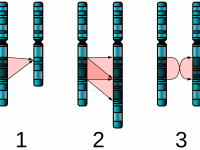![Karen Horney (1885-1952) [photo: Smithsonian Institution Archives]](http://scihi.org/wp-content/uploads/2014/12/KarenHorney.png)
Karen Horney (1885-1952) [photo: Smithsonian Institution Archives]
On December 4, 1952, German Neo-Freudian psychoanalyst Karen Horney passed away. Her theories questioned some traditional Freudian views. This was particularly true of her theories of sexuality and of the instinct orientation of psychoanalysis. She is credited with founding feminist psychology in response to Freud’s theory of penis envy.[4] She disagreed with Freud about inherent differences in the psychology of men and women, and she traced such differences to society and culture rather than biology.
“A person so shut out from every possibility of happiness would have to be a veritable angel if he did not feel hatred toward a world he cannot belong to.”
– Karen Horney, The Neurotic Personality of Our Time (1937)
Early Years
Karen Horney was born Karen Danielsen on 16 September 1885 in Blankenese, Germany, near Hamburg, to Berndt Wackels Danielsen, a ship’s captain, and his wife Clotilde. When Karen was about 9 years old, she developed a crush on her older brother, who became embarrassed by her attentions — soon pushing her away. She suffered the first of several bouts of depression — an issue that would plague her for the rest of her life. In early adulthood came several years of stress. In 1904, her mother divorced her father and left him with Karen and young Berndt. In 1906, she entered medical school, against her parents’ wishes and, in fact, against the opinions of polite society of the time. While there, she met a law student named Oskar Horney, whom she married in 1909. In 1910, Karen gave birth to Brigitte, the first of her three daughters.[1]
Towards Psychoanalysis
As Freud might have predicted, she had married a man not unlike her father. Oskar was just as authoritarian and strict with his children as Karen’s own father was with his. Karen Horney thought this was good, since it encouraged her children’s independence. Her stepmother, Sonni, died in 1911 and this brought more difficulties in her life. This is when she decided to explore psychoanalysis. In 1915, she followed Freudian analysis with Karl Abraham. She began to take patients for analysis in 1919 and worked at the Berlin Psychoanalytic Clinic and Institute until 1932. During this year she joined Chicago Institute for Psychoanalysis. She published papers in the 1920s which described the topic of orthodox Freudians, especially with psychosexuality.[2]
Moving to Brooklyn
In 1923, her husband Oscar, developed meningitis and his business shut down. He rapidly became embittered, morose and argumentative. Also, during this year, Horney’s brother died at age forty of pulmonary infection. This is when she became really depressed and developed thoughts of committing suicide. Then Horney and her daughters moved out of her husband’s house in 1926 and four years later moved to the United States, eventually settling in Brooklyn. Brooklyn was home to a large intellectual community, due in part to a high influx of Jewish refugees from Europe, particularly Germany. It was in Brooklyn that Karen became friends with academics such as Erich Fromm [5] and Harry Stack Sullivan,[11] at one point embarking on an intimate relationship with the former, which ended bitterly.
The Neurotic Personality of Our Time
“Fortunately analysis is not the only way to resolve inner conflicts. Life itself still remains a very effective therapist… The therapy effected by life itself is not, however, within one’s control. Neither hardships nor friendships nor religious experience can be arranged to meet the needs of the particular individual. Life as a therapist is ruthless; circumstances that are helpful to one neurotic may entirely crush another.”
– Karen Horney Our Inner Conflicts (1945)
In 1937 she published the book The Neurotic Personality of Our Time, which had wide popular readership, with the focus on the ideas of neuroses, brought about by cultural factors. Also, how neuroses was based on the disturbances in human relationships. Horney looked at neurosis in a different light from other psychoanalysts of the time. Her expansive interest in the subject led her to compile a detailed theory of neurosis, with data from her patients. She believed neurosis to be a continuous process — with neuroses commonly occurring sporadically in one’s lifetime. This was in contrast to the opinions of her contemporaries who believed neurosis was, like more severe mental conditions, a negative malfunction of the mind in response to external stimuli, such as bereavement, divorce or negative experiences during childhood and adolescence.
Patterns of Neurotic Needs
“It is amazing how obtuse otherwise intelligent patients can become when it is a matter of seeing the inevitability of cause and effect in psychic matters.”
– Karen Horney, Neurosis and Human Growth (1950)
From her experiences as a psychiatrist, Horney named ten patterns of neurotic needs. These ten needs are based upon things which she thought all humans require to succeed in life. Horney modified these needs somewhat to correspond with what she believed were individuals’ neuroses. A neurotic person could theoretically exhibit all of these needs, though in practice much fewer than the ten here need to be present for a person to be considered a neurotic. The ten needs, as set out by Horney are as follows:[2]
- The neurotic has a desperate need for acceptance and affection. Anxiety will occur without these. Neurotics see life as if everything is reasonable and suitable to fit their needs but in reality it is impossible.
- The neurotic has a need for love when in an intimate relationship and expect their partners to take over their lives by solving their problems.
- The neurotic need to make things more simpler by having no routine or rules. Also, when at the point of stress, they want to be unnoticeable and avoid confrontation that may add to their frustration.
- The neurotic needs to have control and power over others.
- The neurotic has a need to manipulate others. They have this need because of their concern of being used or looking stupid. Practical jokes that may be funny to others are often not funny to the neurotic.
- The neurotic has a need to be recognized socially. They are extremely concerned with appearance and popularity. So, they strive to be outgoing.
- The neurotic has a need for others to admire their inner qualities. They are desperate perfectionists, fearing being unimportant or meaningless to others.
- Neurotics need personal accomplishment. They are obsessed with it. They want to be leader of everyone, being top of the world and number one at everything.
- Neurotics need independence. They refuse help from others, thinking they can accomplish things by themselves. Also, if they did receive assistance than it would not be just themselves recognized but the other person as well. They rather have all the attention focused on them individually.
- Neurotics need perfection, hoping that everything in life is just going to get better and better. They fear failure and people finding out that they make mistakes. They feel it is important to be in charge of the all situations.
Later Years
Horney saw narcissism quite differently from Freud, Kohut and other mainstream psychoanalytic theorists in that she did not posit a primary narcissism but saw the narcissistic personality as the product of a certain kind of early environment acting on a certain kind of temperament. For her, narcissistic needs and tendencies are not inherent in human nature. Near the end of her career, Karen Horney summarized her ideas in Neurosis and Human Growth: The Struggle Toward Self-Realization, her major work published in 1950. Karen Horney was undoubtedly a great influence to numerous self-psychologists, humanists, cognitive therapists, psychoanalysts, feminists, and existentialists. As a theorist, leader, teacher, and therapist, Horney made numerous contributions that have been highly significant in shaping and advancing psychological thought. She practiced, taught, and wrote until her death at age 67 in 1952.
Introduction to Karen Horney (Basic Anxiety, Neurotic Needs and Trends, Tyranny of the Shoulds…), [11]
References and Further Reading:
- [1] Dr. C. George Boeree: Karen Horney, at Personality Theories
- [2] Gretchen Langenderfer: Karen Horney, at Muskingum College, 1999
- [3] Books by Karen Horney, at archive.org
- [4] Freudian Slips and other Trifles, SciHi Blog
- [5] Erich Fromm and the Frankfurt School of Critical Theory, SciHi Blog
- [6] Karen Horney at Wikidata
- [7] NYC Municipal Archives / WNYC audio recording of Karen Horney
- [8] Psychoanalytic Social Theory – Karen Horney
- [9] Books by Karen Horney at the Internet Archive
- [10] Harry Stack Sullivan and His Study of Interpersonal Relationships, SciHi Blog
- [11] Introduction to Karen Horney (Basic Anxiety, Neurotic Needs and Trends, Tyranny of the Shoulds…), Perennial Psychology @ youtube
- [12] Dr. C. George Boeree (Psychology Department, Shippensburg University) Personality Theories. Karen Horney
- [13] Paris, Bernard J. Karen Horney: a Psychoanalyst’s Search for Self-understanding, Yale University Press, New Haven, 1994.
- [14] Quinn, Susan. Mind of Her Own: the Life of Karen Horney, Summit Books, New York, 1987.
- [15] Timeline of Women and Psychology, via DBpedia and Wikidata






Pingback: Whewell’s Gazette: Vol. #25 | Whewell's Ghost